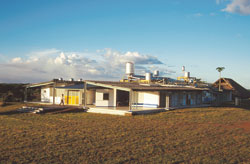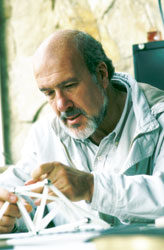Gaviotas by the Glass
When people think about sustainable business or restoring the environment, selling bottled water is the last thing on their minds. But the residents of the remote, rural eco-village of Las Gaviotas, Colombia (population around 200) and their international allies have begun to do just that—market their pure, surplus water to Americans through a grassroots network of mostly volunteers. Despite the cross-continental transportation and plastic bottles required, they expect the project not only to have a neutral or negative “footprint,” but also to support the growth and duplication of this model community and the ambitious reforestation project that supports it.

Understanding how that’s possible requires a little Gaviotas history. Some 30 years ago, the area was a barren, dry savanna set in a region beset by violence and political instability. The acidic soil made it inhospitable to plants or people. In spite of this, Colombian Paolo Lugari decided to collaborate with the local indigenous people, plus scientists and experts from abroad, to develop environmentally sustainable and location-appropriate agricultural techniques and technologies that would provide food, water, health care, jobs and other needs. What did they have to lose?
After much trial and error, they discovered a tree—the Carib pine—and a symbiotic fungus that together allow a forest to flourish. Over time, the growing canopy of trees and their dropped needles attracted greater biodiversity, cooled the soil and brought clouds as well as rain. Now covering 3,200 acres and home to about 250 species, the forest plantation produces enough clean water to supply the entire community for free. It also employs people in the village.
Innovative windmills pump water from the plantation’s shallow aquifer, which is then purified in the village’s 100 percent solar-powered facility, a former hospital. The extra water is hand bottled and sold throughout Colombia in Lego-like containers designed to be used as kids’ toys or building materials rather than discarded. The bottled water is delivered to the capital of Bogota in biodiesel-powered, trucks.
Now Gaviotas’ founders want to expand the forest to perhaps 32,000 acres. In addition, work is under way on another large reforestation-based community on the site of the former Marandua air force base. To cover the costs of jump-starting the project, they decided to appeal to customers abroad, the “strange people in the world who pay a lot for Fiji and Evian water,” explains Gunter Pauli, lead designer for the new eco-community and founder of Zero Emissions Research and Initiatives Network (ZERI), which advocates a systems approach to designing communities.
The project works through a loosely organized group of U.S. residents that tap into their local networks to find families, shops and restaurants willing to purchase the bottled water on a contract basis. All profits (after overhead) are plowed back into the project to plant more Carib pine and African palm trees at Gaviotas and the new site. The idea is to create more greenhouse gas-trapping carbon sinks, and provide wood for residents to convert to steam heat and biodiesel. This process more than offsets the inputs and waste generated.

The benefits of this program are significant: drinking one 32-ounce bottle a day for 25 years supports reforestation of 22.5 acres with almost 10,000 trees. One bottle a day also creates at least one job and eliminates up to 162 tons of carbon dioxide emissions per year for 50 years (the time it takes a tree to grow).
In 2005, Pauli asked 26-year-old Brandon Pitcher, a sustainable systems-design student who has toured Gaviotas, to serve as point person for water sales. “This is the most sustainable project I’ve ever seen, and I’ve been to 30 or 40 countries,” says Pitcher. “This is the only water you can buy that regenerates the environment instead of destroying it.”
The anticipated product rollout date is the end of 2006, pending Food and Drug Administration (FDA) approval. A website—complete with a tree-planting cam—is planned for online sales.
Gaviotas Water is admittedly an experiment, with seemingly as many detractors as enthusiasts. Friends of Gaviotas listserv participant Dave Johnson complains, “The promoters of bottled water foster the idea that the fortunate few can buy their way to good health
” Erik Olson, author of the Natural Resources Defense Council’s 1999 report on bottled water, adds, “The bottom line is that we’re concerned that as more people move from municipal tap water to bottled water, support for water infrastructure may erode.”
To Paul Schwartz, national policy coordinator of Clean Water Action, “That type of solution-oriented thinking is something U.S. communities need. But, even with the benefits, are people willing to spend 200 to 10,000 percent more for their water? If the money that goes into bottled water went instead for pollution prevention and infrastructure, the U.S. would have the Taj Mahal of water quality.”
Then there’s the matter of the plastic bottles, made from the petroleum-based phthalate PET. Pitcher is researching plant-based alternative plastics, but “right now…it’s a problem because we don’t want to use genetically modified corn. Yes, it’s biodegradable, but not that efficient to produce,” he says.
Advocates emphasize the bigger picture. Philadelphia chiropractor Terrie Lewine, a volunteer water sales rep who was impressed by the health and well-being of the Gaviotas residents she met, believes, “It is different from other bottled water. We had a heart connection with that place and the residents, and want to do whatever they think will serve them.” Pauli adds, “You have to see the system and not the bottle.”

